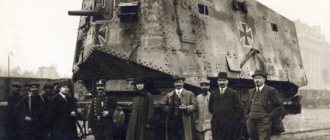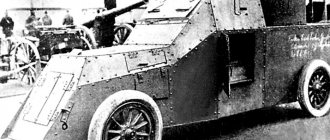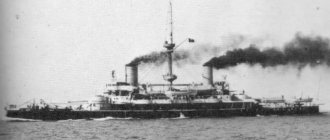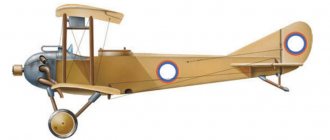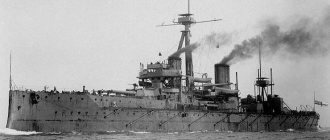Home » Real story » History of Wars » Tin tadpoles. Small submarines type UB I. Germany
History of WarsLittle-known and unrealized projects of ships and other naval equipment
byakin 05/19/2019 1888
19
in Favoritesin Favoritesfrom Favorites 8
The first attempt at unrestricted submarine warfare: the sinking of the Lusitania and the tactical stalemate
Although submarines appeared long before the First World War, at the very beginning no one knew what to do with this type of weapon.
The admirals wanted to use them for a surprise attack from under water. However, the boat ran underwater on batteries, which had a small range, and the underwater speed was inferior to the slowest of passenger ships. That is, the boat could not catch up with the surface ship and only passively waited for them where they passed most often (at lighthouses and capes). At first it had an effect - this is how the Lusitania was sunk in May 1915. It was only after this that the British quickly realized that it was better to stay away from such disastrous areas. “Catching” steamships has become much more difficult. In addition, the sinking of the Lusitania caused a huge uproar, which revealed another problem with submarines - a moral and ethical one. According to the existing law of the sea, a warship sank a civilian ship only after stopping and signaling with cannons, and only after searching and rescuing the crew (and passengers). This was suitable for a surface cruiser, but was guaranteed suicide for the entire submarine fleet. Even a small “merchant” could sink a nearby submarine simply by ramming its thin hull. In addition, the British quickly armed civilian merchant ships with cannons. Since the fall of 1914, they began to prepare and launch trap ships - at first glance, “traders”, to which German submariners were supposed to send inspection teams, after which the trap ship would drop camouflage shields from the guns and shoot the submarine.
Inspection under such conditions was unrealistic, and the Entente quickly took advantage of this by starting to transport military cargo on merchant and passenger ships. The notorious Lusitania is often described as an example of German barbarism. Much less often they remember that there were millions of rounds of ammunition and many projectile elements on board. Even rarer is that the Germans, three months before her sinking, announced that they would sink all ships in the waters surrounding Britain. As the First Lord of the Admiralty, Admiral Fisher, later noted: “A submarine can do nothing more than sink a captured ship... Without a doubt, such methods of warfare are barbaric. But, in the end, the essence of any war is violence. Gentleness in war is akin to dementia.”
Within the framework of the norms that existed in the civilized Anglo-Saxon world, the Germans could either start drowning without warning or rescue, or admit to their own dementia. This means they had no choice but unrestricted submarine warfare. Although it was suspended after the sinking of the famous liner, it was hardly a matter of softening souls. Germany had three dozen active submarines in 1915. With such forces, she could only tease Britain, but not establish a blockade of the “mistress of the seas.”
The widespread accusations that this approach is barbaric are questionable. Their main source was Britain, whose armed forces at that time were headed by Lord Kitchener. 15 years before the Lusitania, he caused the death of 24 thousand women and children from the civilian population of the countries he destroyed. A state that has such a military leader cannot accuse anyone of barbarism. Throughout the First World War, 15,000 civilians, mostly men, were killed by German submarines. If the Germans are barbarians, then what words should be chosen for the English or Belgians in Africa, India, and the Middle East?
“As a result of a combination of wrong actions...”
On May 31, 1904, destroyer No. 150 was renamed Dolphin, and sank on June 16 (29), 1904. Of the 37 people on board, only twelve managed to escape. The first disaster in the history of the Russian submarine fleet claimed 25 lives.
And the following happened. The boat was designed in such a way that when diving, air from the water-filled tanks was vented into the hull, and if so, then to equalize the pressure, the top hatch had to remain open until the very last moment. And only when the wheelhouse was already at water level, the hatch had to be quickly and deftly closed.
On June 16, a training dive took place near the wall of the Baltic Shipyard. In the absence of the boat commander, Beklemishev, he was escorted by Lieutenant Cherkasov. The boat was heavily overloaded, instead of 10 people according to the staff list, there were 37 on it (three officers and 34 lower ranks), while only four belonged to the regular crew of the Dolphin.
The boat was pushed away from the wall. Cherkasov gave the command to fill the ballast tanks. The officers smoked at the top near the open hatch, and then began to go down. But due to the overload, the boat sank faster than usual and almost immediately water poured into the hatch. The panic began. Someone jumped out of the hatch while others tried to close it. Three sailors, including two helmsmen, managed to get out, the fourth was pinched, and the hatch could not be completely battened down. Water quickly flowed into the gap. The boat sank to the bottom, people were trapped. When they managed to pull out the body of the dead sailor and batten down the hatch, the air cushion in the boat was no more than 30 centimeters
By this time, only those who managed to stay on the upper tiers of the batteries were alive, but fuel vapors from the gasoline tank damaged in the panic were already entering the air. People began to choke.
So that at least someone could escape, the hatch was opened again, but only halfway. Two officers and seven sailors managed to escape from the sunken boat. The last sailor to emerge from the surface, Telov, said during the investigation: “The water then completely filled the boat, and through this water I saw how the shadows of people stretched up to the exit from the wheelhouse from inside the ship.” A total of 12 people were saved. 25 people, including Lieutenant Cherkasov, were killed.
The commission that investigated the Dolphin disaster came to the conclusion that the death of people and the sinking of the boat was to blame for “the totality of incorrect actions of Lieutenant Cherkasov,” who could no longer say anything in his own defense. Nothing was said about the design flaws of the project and the complete lack of life-saving equipment, however, during the repairs that followed the rise of the Dolphin, the hatch was equipped with a counterweight.
"Dolphin" after the rise. July 1904.
Image from the collection of P. Kamenchenko
During the lifting of the boat (June 18) and pumping water out of it, two explosions occurred of gasoline vapor and an explosive mixture (hydrogen with oxygen), which had accumulated inside the hull due to the decomposition of water by the current of the batteries and the closure of electrical circuits. Four of the sailors who had previously escaped were injured in the explosion.
The victims were buried at the Smolensk Orthodox Cemetery on Vasilyevsky Island. The mass grave of the sailors and Lieutenant Cherkasov has survived to this day.
Immediately after the boat was raised, repairs began, which were completed by mid-September. By this time, Beklemishev had been promoted, becoming the head of the training of diving detachments, and reserve lieutenant Georgy Zavoiko was appointed commander of the Dolphin.
Russian Emperor Nicholas II inspects the first Russian submarine
Image from the collection of P. Kamenchenko
Last trump
By 1916, the blockade of Germany's maritime trade left it without imported fertilizers and food. There was no famine yet, but the children's immunity was weakening from malnutrition and the number of deaths from common childhood diseases began to increase frighteningly. Moreover, without imported materials, the growth of military production slowed down greatly, and the Entente countries regularly drew resources for their military-industrial complex from the United States and the colonies. Berlin had a natural desire not to remain in debt.
In the same year, the Germans conducted a study according to which Great Britain was losing the ability to provide itself with food by losing supply ships at 600,000 register tons per month. Based on it, the military presented the government with a plan for unlimited submarine warfare. German Chancellor Bethmann-Hollweg assessed its prospects very highly, calling it “the last trump card.” Since February 1917, the German fleet tried to use this trump card.
At first everything went very well. In February - April, at the cost of the loss of nine submarines, ships worth 2 million registered tons were sunk. At this rate, by 1918 the British would have nothing to supply their islands with. The extensive practice of sinkings quickly led German submariners to the tactics that Admiral Tirpitz had proposed for torpedo boats since the beginning of the 20th century.
The Germans began to attack more often at night from the surface. Their surface speed was around 16 knots, that is, faster than merchant ships, and their underwater speed was only 9 knots. Finally, the boats had the opportunity to pursue the enemy, which they had not previously had. It was very difficult to see them at night before the advent of radars (a low silhouette against the background of the waves), but from afar they saw surface ships with their high sides and chimneys.
Unlike torpedo boats, the boats had a large range, and when enemy warships appeared, they could quickly dive and escape from them. It seemed that the ideal weapon for naval warfare had been found. What the Germans planned for their night torpedo raiders was realized at a fundamentally different technical level, which allowed them to lose only three boats per million registered tons of British losses. The situation was truly a crisis - wheat reserves in the British Isles were reduced to six months, which is not enough in conditions of war and vulnerable communications.
Useless tins that stink of kerosene
At the beginning of the 20th century, people imagined the future war to be completely different from what it turned out to be in reality. In the imaginations of military romantics, galaxies of heroic cavalry were supposed to swiftly move across the battlefields, huge zeppelins would shine with silver in the skies, and snow-white armored giants would dominate the seas and oceans. These illusions quickly dissipated. On land, exhausted, lousy infantrymen lived for years in dirty, water-filled trenches, pelting each other with thousands of tons of shells and gassing each other. Tiny biplanes buzzed in the air like mosquitoes, and at sea... At sea, the new century came, perhaps, faster and more clearly than anything else. In one morning hour on September 22, 1914, huge, new and terribly expensive warships, considered the pride and support of the nation, turned into “tame elephants”, which were ambushed with almost impunity by “disgusting kerosene-smelling tins.”
1906 One of the first French submarines at Dunkirk
Image from the collection of Peter Kamenchenko
There is something attractive and at the same time repulsive in a submarine, like the courage of suicide bombers who despise knightly customs of combat. The famous British admiral John Jervis called submarines “a vile and damn un-English weapon.” Moral costs, but to a greater extent the insufficient level of development of equipment and technology, for a long time did not allow the fleets of European powers to receive a submarine that would be a real weapon.
Until the advent of reliable and powerful internal combustion engines, advanced batteries and air regeneration systems, submarines remained meaningless and dangerous toys, whose combat effectiveness was considered negligible. Actually, that’s what they were, used at best as movable minefields to protect ports.
The experience of the Russo-Japanese War only confirmed the skepticism about the capabilities of submarines. The Russian submarines “Dolphin”, “Kasatka”, “Scat”, “Burbot”, “Som”, “Field Marshal Count Sheremetev” did not have any influence on the course of the naval war, as did the five submarines ordered by the Japanese from John Holland in the USA.
The unbreakable genius of the British Navy
The situation for London looked even worse because the English fleet was commanded by Admiral Jellicoe, who was considered very talented. As we now know, it was he who achieved in the Battle of Jutland that for every two Englishmen killed there was only one German. But in 1917, few people knew about such an incident in Britain. Moreover, local propaganda declared the incident a victory for the Grand Fleet. Jellicoe was a typical British officer of that time, that is, he did not read very much and knew the history of naval wars rather poorly. This played a cruel joke on the British merchant fleet.
The fact is that there has been nothing new in the threat to trade since the 16th century, and then the means of combating it began to appear - the convoy. A long column of ships follows a course unknown to the raider in advance, and it is difficult to find it in the sea desert. Even if the enemy is lucky, one pirate (or submarine) will face dozens of ships. It is clear that the attacker will not be able to drown everyone. In Mahan’s works for sailors who played the role of “Capital” in the USSR or the Bible in the Middle Ages, the issue of convoys was dealt with in great detail, and it was also indicated that this was the only effective way to combat raiding.
Alas, Jellicoe did not want to hear about it. He and his like-minded people - that is, almost all British admirals - believed that convoys lead to long periods of downtime for ships (when assembled in ports) and their underutilization. Britain lost 2 million registered tons of ships in the quarter? It doesn’t matter, we need to bring in extra transport from the colonies, since food there is not as needed as the white population of the metropolis. As a result, famine began in Lebanon, and in England more than 100 thousand women were mobilized to work in the fields. Jellicoe's failure to understand that keeping ships in port was better than being stuck on the seabed forever was incredibly persistent. Even in his post-war memoirs, he spoke very negatively about the convoys.
British version of the battle on September 22, 1914
To make the story more objective, we will give the British version of events. Here is the official report on the death of the cruisers of the Cressy commander Bertrand Nicholson:
“September 22 at 7 o’clock. 25 min. In the morning, while on patrol duty, the Abukir exploded on its starboard side against a torpedo. “Hog” and “Cressy” began to drift. “Hog” stood on the bow of “Aboukir”, and “Cressy” was 400 yards from the port side. As soon as we noticed that the Abukir was sinking, we lowered lifeboats and longboats from the Cressy. Just as rescue boats full of people were approaching the Cressy, a second explosion was heard and the Hog sank. In all likelihood, the torpedo exploded under the powder magazine of the 23.4-centimeter guns, located in its stern, since the first explosion was immediately followed by a second, equally deafening one.
As soon as the Hog exploded, a submarine periscope appeared on the surface, 300 yards from the port side of the Cressy. We immediately opened fire on him and gave full speed to ram the boat.
Our gunner Dougherty stated that he hit the periscope with a shell, after which the cabin of a boat appeared above the water, which he also fired on, and the boat sank. The artillery officer denied this, but the crew insisted on the correctness of the gunner's testimony and greeted his success with joyful shouts and applause. In any case, the above boat did not fire torpedoes at the Cressy.
In this battle, Britain lost 1,459 sailors, which is almost three times more than in the Battle of Trafalgar
Image from the collection of Peter Kamenchenko
Captain Ionson maneuvered among the drowning people from “Abukir” and “Hoga” in order to assist them. Five minutes later, the periscope of another boat appeared on the starboard side of the Cressy. We opened fire on it and saw on the surface the mark of a torpedo fired at us at a distance of 500-600 yards. It exploded on the starboard side of the Cressy's rear bridge. The ship tilted 10 degrees to starboard, but continued to float. It was at 8 o'clock. 15 minutes.
While the torpedo was approaching us, we managed to close all the hatches and watertight bulkheads and throw wooden objects overboard: chairs, tables and other furniture, as life-saving equipment for drowning people. The second torpedo fired by the submarine passed us at a distance of 20 feet from the stern. A quarter of an hour after the explosion of the first torpedo in the Cressy, a third torpedo was launched, which exploded in the 5th stoker. It was at 8 o'clock. 30 min.
The ship began to quickly lie on its side until it turned over with its keel up. It remained in this position for 20 minutes. At 8 o'clock. 55 min. it disappeared under water. Most of the crew were saved thanks to the floating objects we threw out. The second torpedo that hit the Cressy almost exploded on its way onto the wreck of the sinking Abukir. It is possible that all three torpedoes were fired at the Cressy from the same submarine. The team behaved brilliantly..."
USA to the rescue
Fortunately, German diplomats more than compensated for the stupidity of the British naval commanders. They had a natural expectation that the accidental sinking of American ships would lead Washington to war with Berlin. Therefore, German Foreign Minister Arthur Zimmermann sent a proposal to the Mexican President to take the side of the Germans in this case. For support, he promised assistance with weapons (being in complete blockade) and recognition for Mexico of those territories that it could seize from the United States. As we can see, Zimmerman was monstrously incompetent. At that time, as today, Mexico was militarily incomparably weaker than the United States and could only start a war with them in a very bad dream.
However, even such a proposal would not cause trouble. The telegram looked so idiotic and out of touch with reality that no one really believed that its author was from Berlin. Many people, including the extremely influential media tycoon Hearst, whose opinion was already becoming key to drawing the United States into wars, considered this to be a fake by British intelligence, trying in such a rude manner to drag Washington into an unnecessary war. But it was not so easy for Zimmerman to be knocked off course: in March 1917, for some reason, he publicly admitted that the telegram was indeed his doing.
Judging by the activities of the German Foreign Ministry in those years, Zimmerman did not at all want the destruction of his country. It is obvious that the Germans systematically underestimated the abilities of other peoples. The United States, which they judged from the press and American popular culture, was considered extremely disorganized and morally corrupt, incapable of quickly mobilizing forces, and not posing the slightest military threat. However, the residents of our country know firsthand that the Germans incorrectly assessed not only the Americans.
The entry of the United States into the war played a key role in turning the tide of the Battle of the Atlantic. Firstly, a large American merchant fleet began to actively participate in supplying Britain. Secondly, American destroyers and other ships began to be involved in the fight against submarines. Thirdly, and most importantly, the admirals from the States were against the idea that without convoys, “American ships would not go to Great Britain, but straight to the seabed.” Under their pressure, in August-September, after desperate resistance, Jellicoe nevertheless accepted the convoy system; fortunately, it was difficult to object to the Americans, who provided ships for anti-submarine warfare and were lending money to Britain with all their might.
After the introduction of the convoy system, monthly Allied losses fell by half and never returned to two million tons per quarter. It was almost the first time that the “Mistress of the Seas” submitted to the will of another sea power, and if not for this, her position would have been extremely difficult.
German answer
As we have already noted, at that time neither convoys nor the fight against them were new. Back in the 17th century, it was noticed that if the defenders gather in groups, then the attackers also need to group their raiders. It would seem that this is a simple idea, accessible even to the admiral. But it was not there. Although lower-ranking submarine officers repeatedly asked to release groups of submarines into the sea, the admirals decided to do this only once.
In May 1918, they sent a group of six submarines to attack convoys. The commander of a German submarine group tried to control each captain, preventing them from acting independently, and in the end found it very difficult to do this. The submarines pursued the convoys in a group, but their attacks were not simultaneous, although radio telegraphy made them possible if they were on the surface.
The admirals did not think about the fact that a single, and even the very first, experience cannot be indicative of a whole new tactic. They simply refused all further proposals for such actions from the captains. Unrestricted submarine warfare was lost precisely because of this decision. In 1918, the Germans sank 2.75 million registered tons at the cost of 69 submarines - a disaster compared to February - April 1917.
A perfect day to sink a ship
On 20 and 21 September 1914 there was a severe storm in the North Sea, which forced the British destroyers to abandon their heavy cruisers and return to base. It was believed that the risk of attack by submarines in such weather was minimal, since they would not be able to stay afloat on a short and high wave. While patrolling the water area allotted to them, the cruisers had to sail in alternating courses at a speed of at least 12 knots. The British ignored both rules.
At 7 o'clock in the morning on September 22, 1914, the heavy cruisers Abukir, Hog and Cressy were heading straight at a speed of 8 knots
Image from the collection of Peter Kamenchenko
U9 left Kiel on September 20 and also encountered a storm. The gyrocompass malfunctioned and the boat went off course, nearly running aground off the coast of Holland. Having reached deep water, Weddigen ordered to dive to 30 meters to rest, but strong excitement was also felt at depth. The next morning the storm subsided and the boat surfaced to charge the batteries.
This is how U9 first mate Johann Spiess recalled it: “The sun rising in the east filled the clear sky with bright light. There was no storm. There is not a cloud in the blue sky. The sea was calm and visibility excellent. A perfect day to sink a ship."
And the goals were not long in coming...
The most effective weapon of war
German submarines during the First Battle of the Atlantic sank 5,000 merchant ships worth 12.85 million register tons, 104 warships and 61 decoy ships. In most cases, casualties on sunken ships were small, especially after the introduction of convoys, when their crews picked up people from other ships. Of the non-uniformed Allied citizens, 15,000 died. 178 German submarines were destroyed in battle, another 39 sank from design defects and crew errors, and a total of 5,100 submariners died—three out of ten. The likelihood of dying for a submariner was many times higher than that of a soldier at the front.
These results were achieved exclusively with small forces. The tonnage and crew of all German submarines participating in the battles were many times smaller than that of the German surface fleet, which had much less influence on the war at sea. And yet, despite such serious successes, this experience was rather poorly studied and understood after the war. Germany entered World War II with just a few thousand submariners—there were 78,000 military sailors in total.
Such weakness at the beginning of the war led to the fact that the Germans, fortunately, failed to win the second Battle of the Atlantic. Great Britain and the USA did not take into account the lessons of unlimited submarine warfare, which is why their victory came at the cost of losing 15 million tons of ships. But these two countries had so many resources that they could afford to study during the war. Germany, for which the main front was the Eastern, did not have such luxury.
How one submariner did not feed seven admirals
Why were the lessons of the First World War not taken into account by either side? The reason for this is insanely simple: not one of the admirals who determined the naval policy of the Reich or the British Empire was a submariner. They didn't understand the submarine service. The British treated submarines as a weak weapon, and, focusing on the success of the convoy system, they believed that they could easily cope with them in the future. German senior naval officials believed that the boats would act alone and did not understand Dönitz's innovations. Therefore, they proposed building large submarines for single attacks. The submariners were against it, because they understood the doom of such tactics when operating against convoys. These disagreements before the start of World War II did not make it possible to choose the type of boats for mass construction, which is why no one started it.
Karl Dönitz, who was a submariner, met World War II as a captain of the first rank and could not have a serious influence on the naval policy of his country. Therefore, his plan for a complete blockade of England with 300 submarines at the beginning of the war had nothing to implement; 57 German boats were not enough for this. It was possible to build a sufficient number of them only by 1942–1943, when anti-submarine aviation acquired a short-wave radar and the night invisibility of the boats ended. For the history of mankind, the blindness of the German admirals played a positive role. A blockade of the British Isles would seriously prolong the Second World War and make it even bloodier.
This blindness is no less important for understanding the military history of mankind as a whole. History in general and wars in particular are usually presented as processes governed by objective prerequisites. The Entente won the First World War, which means it was stronger. The submarines lost, which means they were weak. A close look at armed conflicts raises doubts that everything is so simple. Alexander the Great would never have seen the Indus, and Hitler would not have captured Paris, if victories had been achieved by numbers of men, tanks or guns. The course of a war is determined not by weapons or the number of troops, but by the quality of what they cover with their caps.
“He’s a good guy, but he drank too much.”
The submarines, hastily built and sent with untrained crews, were poorly used in Vladivostok. Inadequacies, defects and various kinds of technical problems prevented commanders from training teams. The help of the port workshops was not enough. Instead of combat training, the personnel were engaged in constant repair of materiel. The living conditions of submariners were no better. They were placed on the Shilka transport, which was completely unsuited to this. “The boat crews are placed disgustingly, badly,” detachment commander Plotto wrote in a report. “People who are tired on the boat do not have a place to rest, and often do not receive hot food.”
Installing batteries on the Dolphin. Vladivostok, 1905.
Image from the collection of P. Kamenchenko
Since February 14, “Dolphin” and “Som” have been practicing scuba diving, making trips to Reineke Island and east to Askold. On May 4, the boat returned to Vladivostok due to a malfunction of the vertical rudder drive. In preparation for repairs, the torpedoes were handed over. The team moved to live on transport. We began pumping fuel from the tanks.
On May 10, the watchmen on the boat were engine quartermaster Syutkin and miner Khamchenko. It was strictly forbidden to let outsiders in, but the service in the detachment was poorly organized and discipline was weak. Khamchenko invited a fellow countryman, a curious non-commissioned officer from one of the destroyers, to visit. It is unknown what they were doing in the land boat; perhaps they were smoking in the wrong place. An explosion followed and the boat sank at a depth of 13 meters. An inquisitive excursionist died, the miner was badly burned. When the boat was raised, several more explosions occurred inside the hull, after which the thoroughly damaged boat was pulled ashore.
Emergency repairs on the Dolphin were completed on October 8, 1905. And a month before that, the Russo-Japanese War ended. Almost the entire Pacific Fleet was destroyed, Russia suffered a humiliating defeat. In the summer, the crew of the battleship Potemkin rebelled on the Black Sea, and in the fall the Kronstadt garrison rebelled. The following year, the sailors of the cruiser “Memory of Azov” rebelled in the Baltic. In Vladivostok the situation was little better. The commander of the Dolphin, Zavoiko, lost the government money allocated for the maintenance of the boat at cards and committed suicide on March 31. “He was a kind fellow and easy to deal with sailors, but he drank too much,” Quartermaster Syutkin recalled of his kind commander.
Vladivostok, summer 1905. "Dolphin" after the rise
Image from the collection of P. Kamenchenko
“The boats were completely neglected due to the absence of officers and lower ranks during almost the entire 1906. The money, given in advance for a whole year, was squandered by the officers or borrowed. The property was half plundered, lost and burned in fires,” wrote captain of the second rank Magnus, appointed commander of the detachment in December 1906, in the report.
